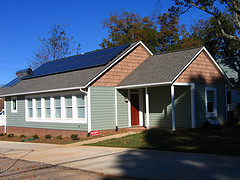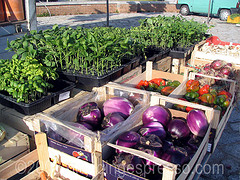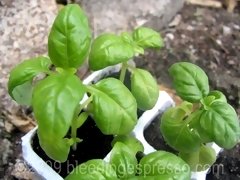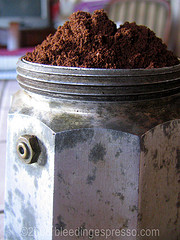Archive for the ‘for a good cause’ Category
Going Green: 4-Step DIY Home Energy Audit
 One of the easiest ways to go green, cut back on the energy you use, and save money all at the same time is by performing a DIY home energy audit.
One of the easiest ways to go green, cut back on the energy you use, and save money all at the same time is by performing a DIY home energy audit.
And spring just happens to be a great time to do a home energy audit, especially if you’ll be using air conditioning throughout the summer and don’t want to lose your cool air through leaks.
As someone who lives in a centuries-old house, I can assure you that following the DIY steps below can make both your energy bills more pleasing and your house temperature more comfortable year-round without spending any extra money on heating or cooling.
Indeed, the US Department of Energy recommends doing a periodic home energy audit to make sure you’re not paying for and then losing valuable energy—and shares how to do it in four easy steps:
4-Step DIY Home Energy Audit
1. Check for leaks.
Plugging up energy-sucking drafts can save you up to 30% annually, so have a look around your house to see where air might be escaping.
Any gaps along the baseboard, in the foundation, at junctures of walls and ceilings or around pipes, wires, electrical outlets, mail slots, door and windows need to be sealed.
Caulking or weather stripping will usually do the trick.
2. Check insulation.
Be sure that the insulation levels in your home are at least at the recommended minimums; this is especially important to monitor if you have an older home as recommended levels may have changed since the insulation was first installed.
 3. Check lighting sources.
3. Check lighting sources.
As 10% of your electric bill comes from lighting, you should be sure that you aren’t using higher wattage than necessary; you should consider compact fluorescent light bulbs especially for areas that are lit for hours at a time.
4. Check heating/cooling equipment.
Make sure filters are clean and in working order and that ductwork is clear of dirt streaks, which mean that air is leaking out.
Moreover, if you’ve had your unit for more than 15 years, it may be time to consider replacing it with a new, more energy efficient model.
For more detailed instructions on how to perform a do-it-yourself home energy audit and for more energy (and money!) saving tips, visit the Department of Energy’s Consumer’s Guide to Energy Efficiency and Renewable Energy.
Have you done an energy audit of your home? Will you?
Buon weekend!
NIAF/Abruzzo Relief Fund for Victims of Abruzzo Earthquake
 By now you’ve surely heard of the devastating earthquake in the city of L’Aquila, Abruzzo, Italy.
By now you’ve surely heard of the devastating earthquake in the city of L’Aquila, Abruzzo, Italy.
As I type, the death toll is nearing 200 and some estimates put the number of newly homeless at 50,000. Others are still missing, people are sleeping in their cars (if they have them), and food and fresh water is scarce.
I thank all of you who have contacted me to make sure we’re OK; we are just fine as we’re quite far from L’Aquila, but I do ask you to please consider helping those who have been affected by the Abruzzo earthquake by donating to the:
NIAF/Abruzzo Relief Fund
For US taxpayers, donations are tax deductible, and rest assured the National Italian American Foundation is an extremely reputable organization.
On the Italian end, you can also donate to the Italian Red Cross:
Croce Rossa Italiana
Thank you for your kindness.
Going Green: Start a Garden, Support Local Farmers and/or Join a Community Garden
Welcome to the third installment of Going Green!
Previous Going Green posts include:
 Now, just in time for Spring, we’re talking about some literal greens—in gardens.
Now, just in time for Spring, we’re talking about some literal greens—in gardens.
By growing your own food, supporting local farmers, and/or joining a community garden, you’ll not only be getting the freshest, healthiest, and most delicious food available, you’ll also help save the planet from some nasty carbon emissions.
What carbon emissions, you ask?
Did you know that in America, grocery store produce often covers around 1,500 miles before landing on the dinner table?And that’s only the stuff actually produced in America–imagine how much traveling imported fruits and veggies do!
All that transportation adds up to a whole bunch of extra *blech* in the air—completely unnecessary as you can grow your own food, participate in a community garden, or simply buy from local farmers’ markets.
Popularity of Home Gardens in America
Home gardens are increasingly popular, not only for the fresh fruits and vegetables but also because they are a great way to save money. The National Gardening Association estimates that about 20% more American households than last year will plant gardens, and many are doing so to pinch pennies.
Hey, even the President Obama and First Lady Michelle are gardening these days! It’s the coolest!
Home Gardens on the Homefront, i.e., Calabria, Italy
 Here in rural Calabria, it’s rather common for people to keep an “orto” full of fruits, vegetables, and herbs. You may remember my mentioning our “giardino” here on the blog in the past, but unfortunately as it doesn’t get much sun, we could never plant much; we had peppers, parsley, basil, and that’s about it.
Here in rural Calabria, it’s rather common for people to keep an “orto” full of fruits, vegetables, and herbs. You may remember my mentioning our “giardino” here on the blog in the past, but unfortunately as it doesn’t get much sun, we could never plant much; we had peppers, parsley, basil, and that’s about it.
But, through a great stroke of luck since Pasqualina came to stay with us, P and I have secured a plot of land very close to the house we’re slowly moving into as it’s remodeled…and it’s gardening time!
 This piece of land gets sun all the live long day, which is perfect for all kinds of fruits and veggies. The “orto” already had lemon, orange, fig, and peach trees, and (after spending *many* hours cleaning up the essentially abandoned land) we have added onions, garlic, lettuce, artichokes, basil, and parsley.
This piece of land gets sun all the live long day, which is perfect for all kinds of fruits and veggies. The “orto” already had lemon, orange, fig, and peach trees, and (after spending *many* hours cleaning up the essentially abandoned land) we have added onions, garlic, lettuce, artichokes, basil, and parsley.
Soon we’ll also plant eggplants, peppers, and, of course, tomatoes! Whee!
Now, some resources to get you started on becoming more green:
How to start a garden:
- About.com Guide to Gardening by Marie Iannotti
- Eat Healthy and Save Money with a Vegetable Garden (ABC.com)
- Planning a Vegetable Garden (National Gardening Association)
- Teach Your Kids How to Start a Garden (Better Homes and Gardens)
- Tomato Casual especially for tomato lovers
- Urban Garden Casual for city dwellers and those who think they have no space for a garden
All about community gardens:
- American Community Gardening Association
- Australian City Farms & Community Gardens Network
- Federation of City Farms and Community Gardens (UK)
- National Garden Association (US)
Find local farmers to support:
- Australian Farmers’ Market Association
- BigBarn – The Virtual Farmer’s Market (UK)
- LocalHarvest.org (US)
- SustainableTable.org (US)
- U.S. Department of Agriculture Farmers’ Market Map
If you know of more helpful sites on gardening, etc., (especially international ones), please share in the comments!
Are you gardening this year? Do you normally garden?
Buon weekend!
P.S. For those wondering what has happened to Cherrye’s My Bella Vita, there are some technical details that she’s working furiously on–don’t worry, she’ll be back as soon as possible!
Going Green: 21 Ways to Reuse Coffee Grounds
 It’s the first Friday of the month, which means it’s time again to talk about Going Green. Last month we discussed green cell phones and cell phone recycling, and today we’re moving on to another way to recycle and reuse.
It’s the first Friday of the month, which means it’s time again to talk about Going Green. Last month we discussed green cell phones and cell phone recycling, and today we’re moving on to another way to recycle and reuse.
And we’re talking coffee. Coffee grounds, actually.
As you well know, I drink coffee, and apparently so do many of you; coffee is the most consumed beverage worldwide with 400 million cups downed each year. Now that creates a lot of used coffee grounds!
Did you know there are lots of ways you can reuse coffee grounds instead of just throwing them in the garbage? Here’s a short list:
21 Ways to Reuse Coffee Grounds (and Coffee)
In the garden:
1. Organic fertilizer: Sprinkle them in the soil of plants that love acidic soils, especially rosebushes (my roses *love* coffee grounds!), rhododendrons, camellias, evergreens, carrots, and radishes.
2. Organic pest and ant repellent: Sprinkle areas where ants, slugs, and snails hang out and destroy your garden.
3. Organic cat repellent: Yes, I love cats, but if you want to keep them out of your plants and garden, coffee grounds will do the trick.
4. Mushroom growing soil: Inoculated mushroom plugs nestled into moist coffee grounds can mean a great mushroom crop for you. Put grounds in a glass container and press a mushroom plug into them, repeating with more grounds and mushroom plugs until you run out of room. If you see mold, just remove it.
5. Bait worm life support: Add coffee grounds to soil to help keep bait worms alive longer.
In the house:
 6. Closet deodorizer: Old pantyhose plus coffee grounds equals a sachet to keep your closet free of odors.
6. Closet deodorizer: Old pantyhose plus coffee grounds equals a sachet to keep your closet free of odors.
7. Refrigerator and freezer deodorizer: Place ground in a small cup and in the fridge or freezer much as you would baking soda.
8. Pin cushion filler: If you still use pin cushions (like I do), dried coffee grounds are a great filler for the cushions.
9. Abrasive cleaner: For stubborn grease and stains on pots and pans, coffee grounds really get in there and do the job.
10. Dust deflector: We’re talking about the fireplace here; sprinkle coffee grounds on ashes before you start collecting them to minimize the dust. I *love* this tip and use it often.
11. Furniture scratch toucher upper: Use a Q-tip and coffee grounds to fill in scratches on wooden furniture–remember the coffee will stain the wood a bit, so don’t use it on something that won’t match.
12. Drain cleaner: Be careful with this one as you don’t want to clog your drain with coffee grounds! *But* to counter odors coming from your drain, you can pour about a half a cup of coffee grains down the drain followed by boiling hot water to get the grounds through. No more smells!
13. Meat tenderizer: This is one for leftover coffee as opposed to coffee grounds; soak steaks in coffee to tenderize and for an interesting added flavor.
14. Chocolate cake flavorer: Used grounds and fresh grounds both give a little kick to chocolate baked goods, including brownies.
In your beauty routine:
 15. Hand soap: Rub grounds on your hands to get rid of stubborn odors like onion and garlic. In fact, the soap I use in my kitchen is made with used coffee grounds–Caffè Vaniglia soap from Saponissimo.
15. Hand soap: Rub grounds on your hands to get rid of stubborn odors like onion and garlic. In fact, the soap I use in my kitchen is made with used coffee grounds–Caffè Vaniglia soap from Saponissimo.
16. Face mask: An egg white mixed with 1/4 cup grounds makes a great exfoliating face mask.
17. Hair rinse: After washing your hair, rub in coffee grounds for shine, softness, and even a bit of color for those of you who are dark-haired; remember coffee grounds act as a dye, so if you have light hair, unless you want highlights, this one isn’t for you.
18. Cellulite rub: Mix one tablespoon of olive oil with 1/4 cup moist, warm coffee grounds and spread on cellulite hot spots. Wrap tightly with plastic wrap, leave on for a few minutes, and then remove wrap and shower as normal. For best results, do a couple times a week. If anyone tries this, you *must* let me know how it turns out.
For fun:
19. Dye: Use a mix of coffee grounds and water to dye clothing, paper, or even Easter eggs.
20. Tattoo base: Make homemade temporary tattoos using coffee grounds and henna.
And finally, on your doggie:
21. Dog flea dip: I haven’t had the nerve to try this one yet, but next bath time, my dogs are getting some coffee grounds rubbed into them after the shampoo and rinse routine.
By the by, even if you don’t drink coffee, you can ask your local coffee shops and other places that serve coffee for their grounds, and start reusing them. The environment will thank you!
Do you currently reuse coffee grounds? How?
If you don’t reuse coffee grounds, which of these suggestions might you try?
Buon weekend & Happy Birthday Dad!
Going Green: Green Cell Phones and Cell Phone Recycling
 Starting today, I will be doing Going Green features every first Friday of the month. I know I’m not nearly as “green” as I should be, and I hope that by focusing on one issue a month, I will inspire both you and me to think a little more about everyday decisions we make that affect our planet.
Starting today, I will be doing Going Green features every first Friday of the month. I know I’m not nearly as “green” as I should be, and I hope that by focusing on one issue a month, I will inspire both you and me to think a little more about everyday decisions we make that affect our planet.
Up first is a bit of information on cell phones. Are you in the market for a new cell phone and also concerned about the environment? Read on.
Choosing a New “Green” Cell Phone
 So the time has come to buy a new cell phone, but you still want to keep the environment in mind. Some of your best “green” cell phone choices are:
So the time has come to buy a new cell phone, but you still want to keep the environment in mind. Some of your best “green” cell phone choices are:
- Samsung E200 Eco
- Nokia 3110 Evolve
- T700 Sony Ericsson
These are all made with eco-friendly materials, packaged in recyclable boxes and bio-plastic, which dissolves in water. The phones themselves even have “green” features, such as the Samsung’s alarm that tells you when recharging is finished so you’re not needlessly using electricity.
So, you have a new cell phone; now what should you do with the old one?
Recycle Your Old Cell Phone
Discarded electronic equipment, or “e-waste,” has become one of the most serious threats to our environment. When cell phones are simply chucked in the garbage, lead, mercury, and cadmium leaked from them into landfills can become real environmental and health hazards.
If you’re in the market for a new cell phone, first you should think about how you’ll recycle your old one. Only a handful of US states require cell phone sellers to provide a free way for consumers to recycle used phones, so you may have to do your own homework; here is a short list of ways to recycle your old cell phone to get you started:
1. Recycle your cell phone through the manufacturer or seller. If your cell phone seller doesn’t have a recycling program, the phone manufacturer probably does: AT&T, Sprint, Verizon, Apple, Motorola, Nokia, Samsung and T-Mobile all have cell phone recycling programs.
 2. Give your cell phone to someone. Whether it’s to your mother who has resisted cell phones up till now or to your young son who has been bugging you to buy him one, passing along your cell phone to someone else will lengthen its life for just a little while longer. Be sure to mention cell phone recycling to the recipient so she will consider responsibly disposing of the phone when she’s done with it.
2. Give your cell phone to someone. Whether it’s to your mother who has resisted cell phones up till now or to your young son who has been bugging you to buy him one, passing along your cell phone to someone else will lengthen its life for just a little while longer. Be sure to mention cell phone recycling to the recipient so she will consider responsibly disposing of the phone when she’s done with it.
3. Donate your cell phone. Many charities accept old cell phones as donations including CellPhonesforSoldiers.com and The Support Network for Battered Women.
Find other organizations that accept old cell phones at Charitable Recycling. And why not organize your own cell phone recycling drive if you want to get further involved?
Have you recycled a cell phone?
Please feel free to leave more recycling and green cell phone ideas (including other organizations that accept cell phone donations) in the comments!














